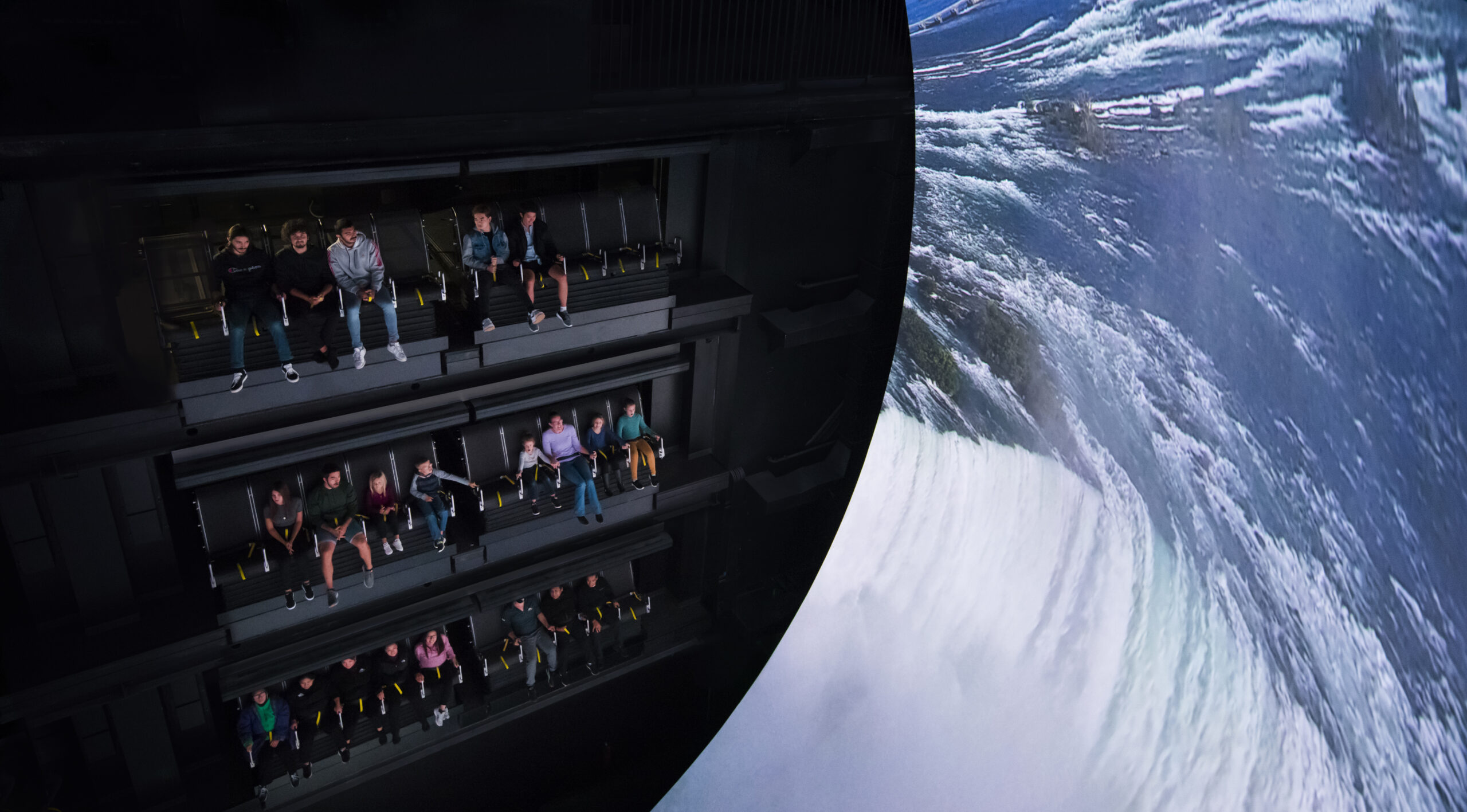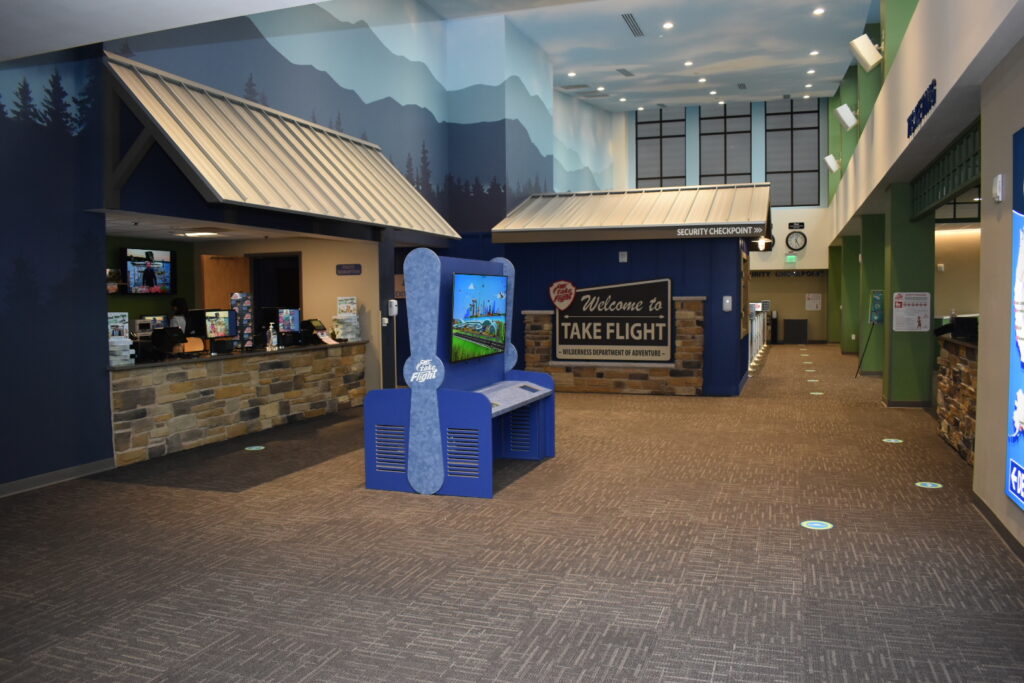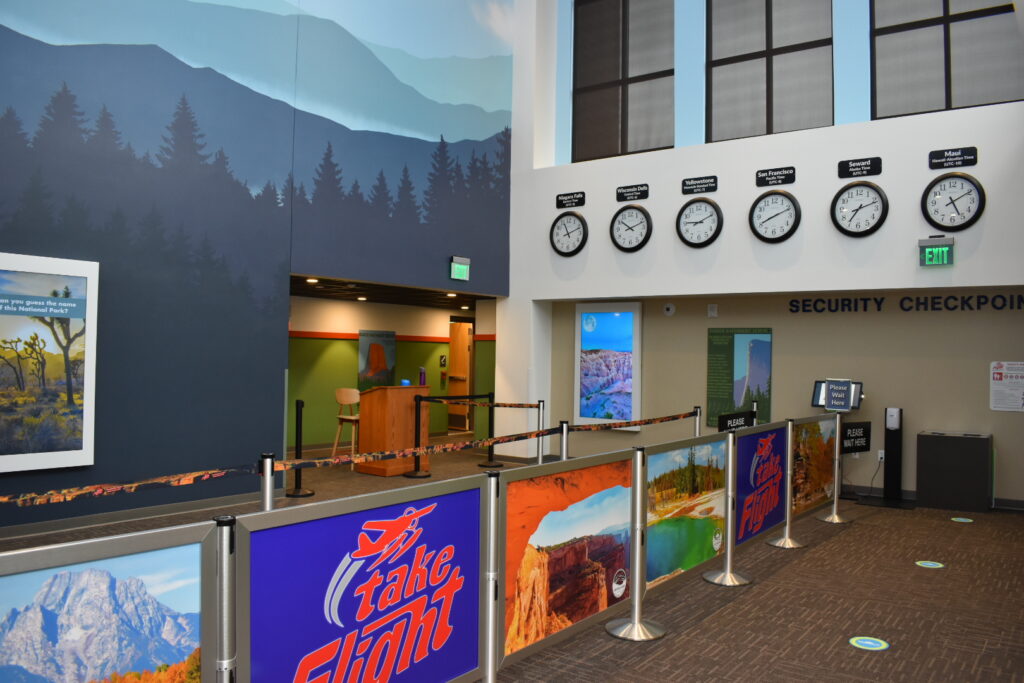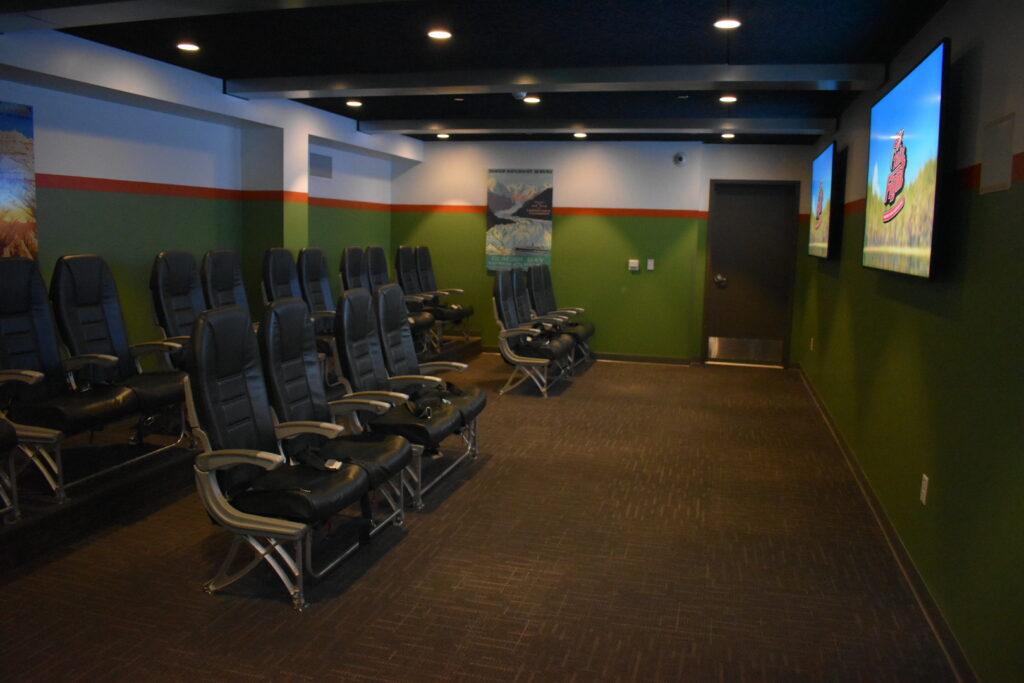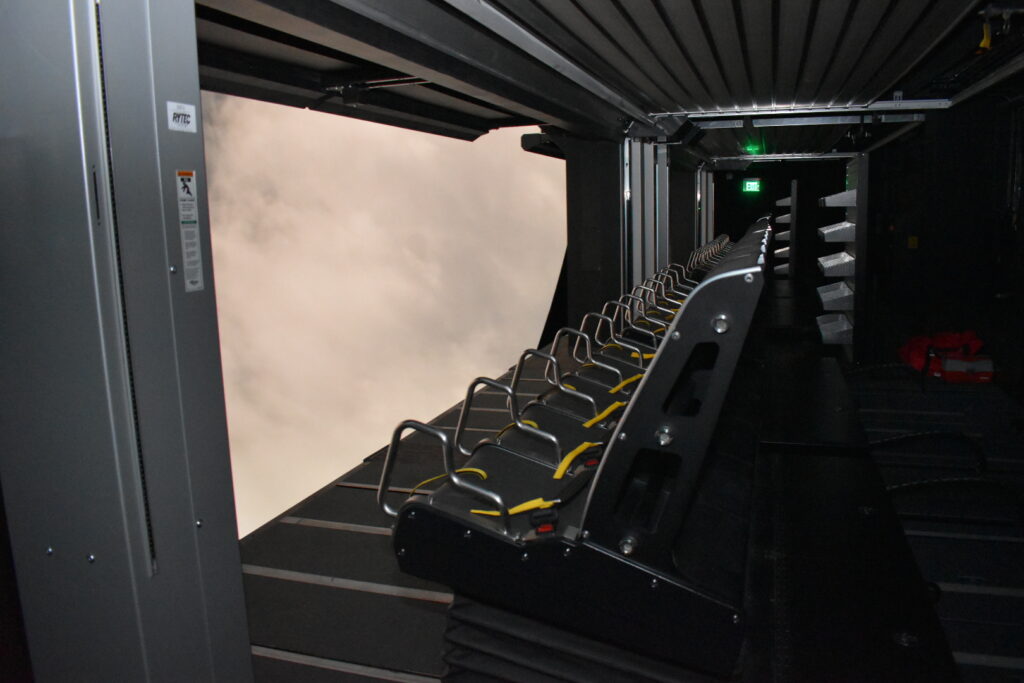SimEx-Iwerks FlyRide® theaters take off in Branson and the Wisconsin Dells
By Joe Kleiman
The motion simulator ride has been around for over a century. According to the late film historian Ray Zone, “Hale’s Tours” was the first on the market utilizing motion picture film; it premiered at the 1904 St. Louis World’s Fair before being franchised worldwide. The concept was simple – riders would board a railroad car positioned on a gimbal, at one end of which a short, point-of-view travelogue film would play. Combined with a rocking motion applied to the car and a wind machine, riders had the sensation they were actually riding the rails.
For close to 80 years, simulator rides in theme parks, carnivals and museums would use this simple concept – vibration of the theater or seats combined with lighting and environmental effects to create the sensation of movement and immerse guests into the experience. In 1985, the game changed as industrial flight simulators were modified for entertainment use and the first, influential modern versions of the product emerged. In Toronto, the company Interactive Entertainment, Inc. – which would soon change its name to SimEx – created “Tour of the Universe,” a blockbuster attraction at the CN Tower. Meanwhile, in Los Angeles Don Iwerks was finishing up the custom projection system for Disney’s original, groundbreaking “Star Tours” attraction. He would soon leave Disney to found his own attractions company, Iwerks Entertainment. SimEx and Iwerks would merge in 2002 to become SimEx-Iwerks.
As the motion simulator ride business grew, companies began looking for new ways to differentiate themselves from the competition. Where riders were placed in small capsules with screens at the front, ceilings began to disappear, with dome and curved screens enveloping riders’ points of view. The next stage would be to simulate a flight over terrain. While traditional simulator vehicles are positioned so riders look forward or up, the joy of hang-gliding is the ability to gaze down upon the world passing below. Engineers shifted the screens lower and created motion bases where guests’ feet dangle, as if actually in flight on a glider. This type of media-based, simulator attraction is commonly referred to as a “flying theater,” and has proven to be a great crowd pleaser. It has followed a typical path of development through the industry, starting with custom, one-off installations in the biggest parks and gradually coming within reach of regional and stand-alone operators as well.
Continuing its role as a leader in the ride simulation market, SimEx-Iwerks has just opened its first two FlyRide® theaters, both at venues in the US Midwest serving regional tourist markets: Wilderness Resort in Wisconsin Dells, and Beyond the Lens in Branson, Missouri. FlyRide® is based on the SkyRide theater system SimEx-Iwerks first developed for Enchanted Kingdom in the Philippines in 2016 [see “Flying High,” InPark Magazine Issue #62]. It is positioned as an economical alternative to big-budget flying theaters, with a scalable system package supported by a film library that includes licensed content and original films. “We try not to do the big one-off custom product, but rather something that’s replicable worldwide,” says Mike Frueh, Senior Vice President of Licensing and Distribution for SimEx-Iwerks. “For FlyRide, we developed a product that is designed, built, installed and serviced by SimEx-Iwerks, just as we do with our 4D Experience® and motion ride attractions.”
“We’re well known as having the largest ride and 4D film library in the market,” Frueh continues. “We’re doing the same for FlyRide®, which is very appealing to our clients since it means they can get both the system and the content from us, and have access to a variety of content.”
The system
FlyRide is a highly customizable system. The seating configuration, screen shape and size, and even the projection are based upon the customer’s needs for the space. Central to the experience are motion platforms, each five seats across. With four platforms spread across each floor, and the ride spread over two to three floors, FlyRides can put through as many as 40 to 60 riders per cycle, though Frueh points out that an attraction can have fewer or more seats, depending on the available space. The modular nature of the attraction simplifies maintenance and allows operators to adjust to changes in demand by running just a single floor or even just one bench if needed.
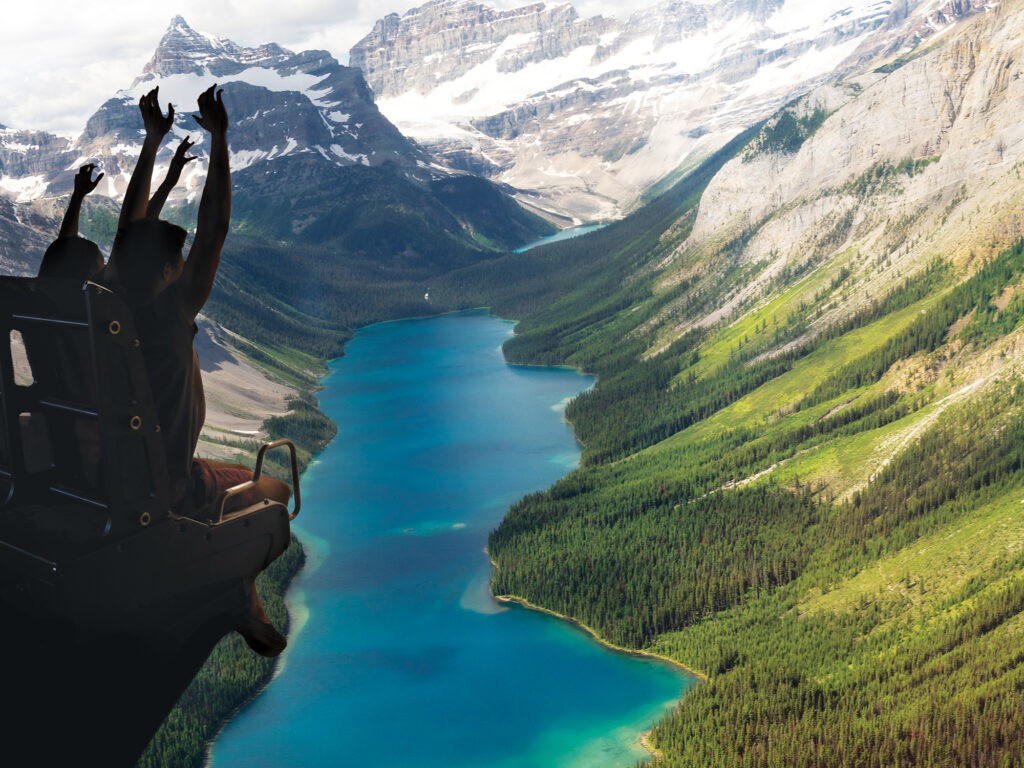
ABOVE AND TOP: Guests on SimEx-Iwerks’ FlyRide® attraction are surrounded by imagery on a giant screen and taken on a flying tour of sites around the United States. All photos courtesy of SimEx-Iwerks unless otherwise noted.
As riders buckle into their seats, they notice a closed door in front of them. The “wow factor” takes place as the door opens and the seats suddenly surge forward, causing riders’ feet to dangle while the experience takes them into simulated flight — this is the Rapid Reveal system in action. Electric actuators, which Frueh notes are quieter than other options and therefore better for flying experiences, provide three degrees of motion (3DOF) – pitch, roll, and heave – to simulate the sensation of traveling on an actual aircraft.
Depending on the size and configuration of the theater, images can be projected onto either a giant dome screen or a more specialized, curvilinear screen supplied by Strong/MDI. Beyond the Lens features a four-story Vista View curved screen, while Wilderness Resort’s is a five-story high, solid partial dome. Main audio speakers are located behind the screen and for acoustic transparency the Vista View screen has a perforated surface while the dome screen has special patented perforated panels at speaker locations. Keeping most of the dome screen solid reduces light loss and maximizes image quality. Surround sound is created through additional speakers located behind the seats in each launch bay.
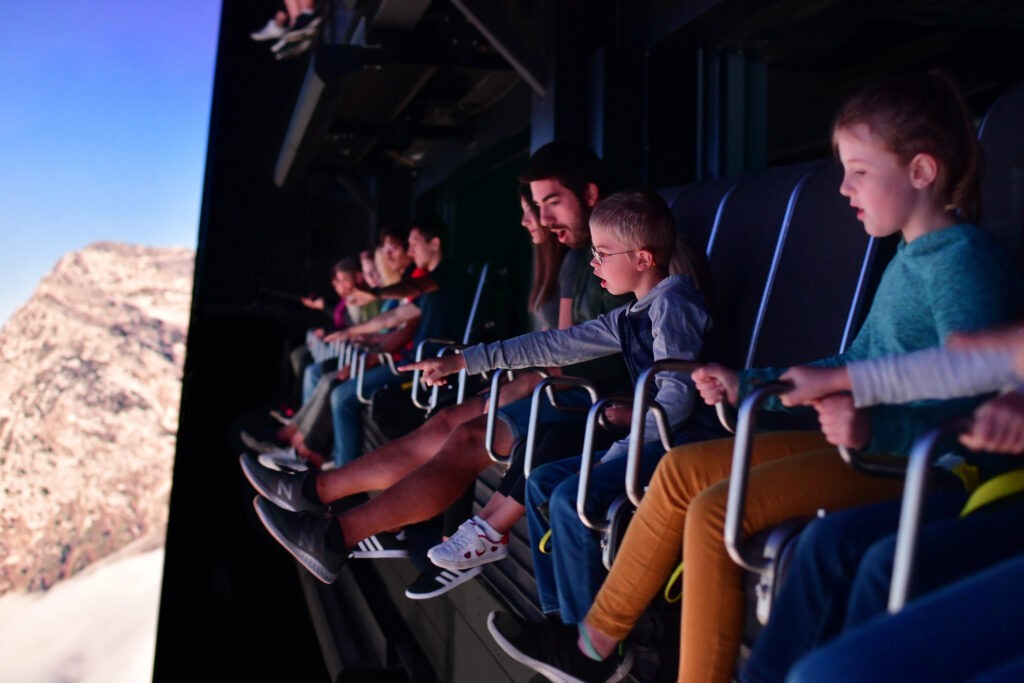
The SimEx-Iwerks ride system tilts seats back before pushing them forward into the curved screen for the show.
The projection systems integrate components from leading manufacturers. Both the Wilderness Resort and Beyond the Lens theaters are projecting at a high frame rate of 60 frames per second, adding to the realism of the experience. Images are played back from 7thSense Delta Media Servers to multiple Christie laser projectors. Wilderness Resort utilizes four Christie D4K40-RGB projectors blended with the Christie Mystique Large Scale Experience software to create a single high resolution image. Beyond the Lens has four Christie Crimson WU25 projectors. Both locations feature scent, wind, and water effects. The system is operated with a patented SimEx-Iwerks designed control system that can be remotely accessed by authorized technicians for monitoring and maintenance. The ride meets worldwide code requirements and has received approval from major authorities such as TUV and CSEI.
The film library
To build a strong aerial content library to support FlyRide, SimEx-Iwerks partnered with an industry master of aerial photography, specialty cinema producer MacGillivray Freeman Films (MFF). Well known as one of the leading producers and distributors of documentary content to IMAX and other giant screen theaters, MFF is probably best known for the 1998 release “Everest,” currently scheduled for a 2021 director’s cut re-release. The company’s longstanding history of aerial photography goes back to the 1960s and 1970s, when surfing documentarians Greg MacGillivray and Jim Freeman began producing and shooting aerials for Hollywood blockbusters, including “The Shining” and “The Towering Inferno.” In 1976, the company’s first IMAX production, “To Fly,” opened at the Smithsonian’s National Air & Space Museum, where it continues to play to this day.
Now, with more than 50 films to its credit, MFF has developed an extensive collection from its high-quality source material. The footage covers a rich variety of topics and terrain in celebration of nature, adventure and the great outdoors, making it a natural fit for flying theaters. “Our shots have stood the test of time,” says MFF President Shawn MacGillivray, “They look incredible.” MFF is in the midst of taking its IMAX film shots, originally captured on 15 perforation 65mm film, the highest resolution film on the market, and digitally scanning them at 16K resolution, providing four times the image detail of most conventional cinemas.
“We’re helping SimEx-Iwerks serve their clients in creating bespoke films that they want for their venues,” says MacGillivray. “They know it’s about wowing audiences, especially as they experience it for the first time. And the next film has to be even better.” The two FlyRide® venues that just opened both have original films using MFF footage, but each is vastly different from the other.
Wilderness Resort in the Wisconsin Dells took a somewhat different approach with its original show “Flying Wild.” “We wanted footage of the national park landmarks, the Grand Canyon and Tetons, but we also wanted to combine that with footage of the Dells,” says Chris Ebben, the resort’s Director of Attractions. “The Upper and Lower Wisconsin River are separated by a dam. Instead of taking a Duck Boat tour of the Upper River and then relocating to float down the Lower River, we offer a bird’s eye view of the whole thing. It’s something most people won’t experience in a single day.” Footage has recently been shot by Wilderness with the help of MFF and Discover Wisconsin of nearby Devil’s Lake State Park and Door County and scenes from both locations will be in the re-release of Flying Wild November 13th, 2020.
For Robin Turner, owner of Branson’s Beyond the Lens, it was important that “some of the clips in our film ‘Adventure America’ take people where they normally would fly to, but would also take them to places beyond their normal travel.” Beyond the Lens is what Turner calls “Techno-Tainment.” Turner, who prior to Beyond the Lens founded the edutainment LBE chain Wonderworks, says the venue concentrates on “being on the cutting edge of what’s next: VR, AR, and other interactive technology. Guests are immersed from the moment they walk through the doors; from photo ops to life-size gaming opportunities.”
Both venues are working on future flying experiences, and both have plans to add a seasonal production in November for the holidays. SimEx-Iwerks is continuing to develop its FlyRide film library with original content from MFF and others. As the number of Flyride venues expands, the supporting content library will continue to grow likewise and differentiate itself from other SimEx-Iwerks content that is more tied to traditional motion simulation and 3D and 4D experiences. “We want to really concentrate on the flying experience,” says Frueh. “We’re also working on a few animated films.”
The venues
Wilderness Resort is a family resort with indoor and outdoor waterparks and other family activities including go-karts and a ropes course. The resort’s $10 million*, 60-seat Take FlightFlyRide attraction is entered through a newly constructed lobby off the main entrance, themed to an airport with windows looking out on the National Parks. New characters have been created that tell the story of a young girl going on a flight. Eventually, guests reach an airport and sit in actual seats from a Delta Airlines plane for their preshow briefing. “We wanted something the Wisconsin Dells doesn’t have,” says Ebben. “We wanted to draw business onto our property. With these ride vehicles, a family of four or five can have their own vehicle.”
TOP ROW: At the Take Flight attraction within the Wilderness Resort (Wisconsin Dells, Wisconsin) great detail has gone into theming the experience from the moment guests enter the attraction. Guests prepare to board a flight that will take them to various National Parks and scenic destinations around the country. The pre-show features repurposed airplane seats. BOTTOM: Each bay of the attraction has two ride vehicles with five seats per vehicle. Two bays are located on each of the three floors. Photos by Martin Palicki.
At Branson’s Beyond the Lens, the $8 million*, 40-seat FlyRide theater was constructed inside a retrofitted, 2,500-seat live performance venue. “It’s technology and entertainment in one, and fits perfectly with our theme,” Turner says. The attraction’s theme is based on a Pan Am-inspired vintage air terminal. “We wanted to give the feeling that you can fly anywhere in the world from here,” he adds.
Turner is planning on adding a second theater, this one larger at 60 seats, to the Beyond the Lens attraction in Pigeon Forge, Tennessee. “We have the only flying theater in Branson. But Pigeon Forge is a bigger market; it’s not as seasonal and has more visitors. Because it’s at the crossroads of three major highways, 70% of the country is within eight hours of Pigeon Forge.”
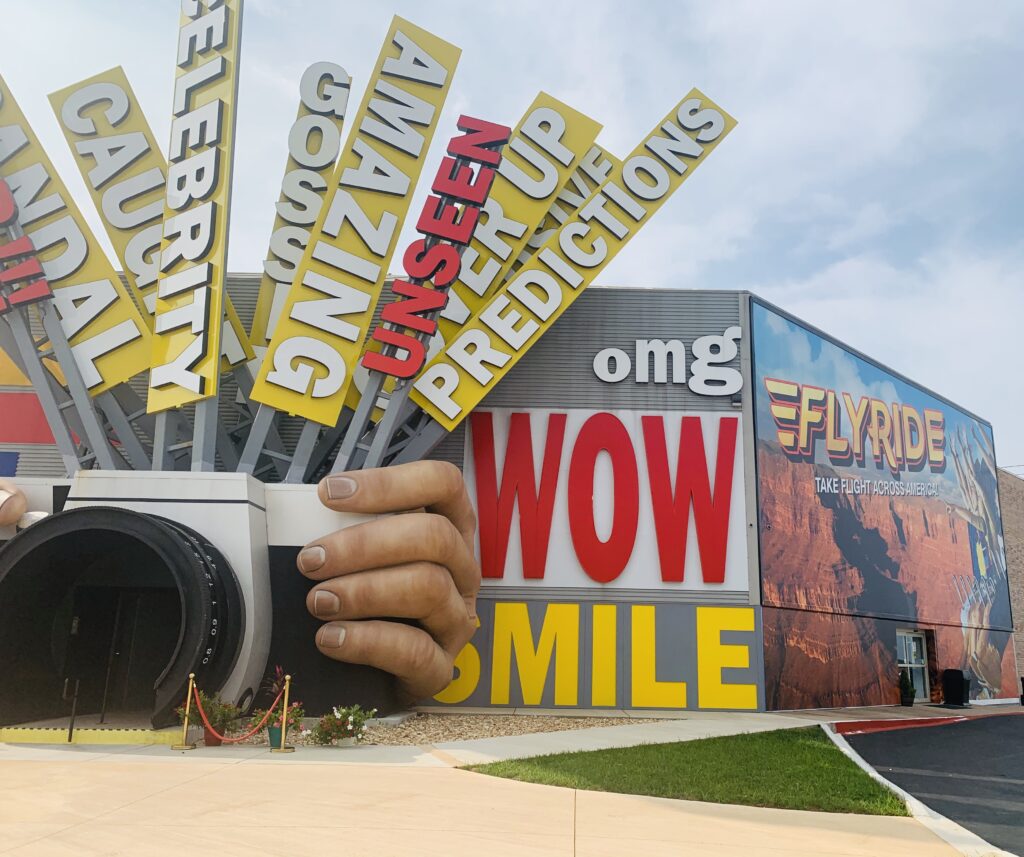
The Branson Missouri FlyRide is a retrofit installation that was previously a 2,500-seat live performance venue.
Turner continues, “Working with SimEx-Iwerks and MFF has been a very good experience. As they develop the film library, the product only gets better. We’re currently working with them on what the second film will be like for the following year. Underwater products look really great for this format. I never thought I would be in the business of working with filmmakers, but this collaboration has taken us to a new level of entertainment for our guests.”
*Costs include FlyRide® system and film production along with other costs, such as theming, building design and construction, not included with the ride system.


